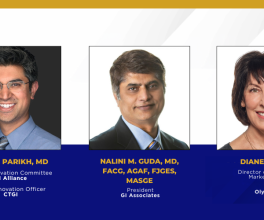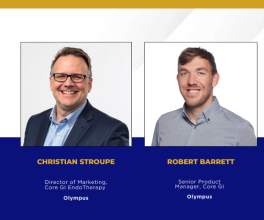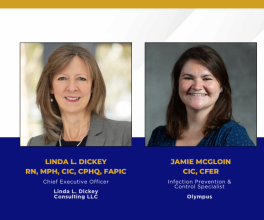
Getting to the Truth: A CAS and a GI Physician Discuss the Nuances of EUS Training and Experience
Summary: Olympus’ Clinical Applications Specialist Melissa Elliott-Walker, and Gastroenterologist Julie Yang, MD, were interviewed on the OlympusTalks podcast on the DeviceTalks platform. The two discussed their respective clinical roles at the intersection of endoscopic ultrasound to access, visualize, and treat GI conditions, as well as the value of training and experience in the quest to get clinical answers.
Melissa Elliott-Walker has been looking at ultrasound images for over three decades. Still, she understands that first-time viewers won’t ‘get it’ right away. “When you’re first looking at an ultrasound image, it looks like sonar…It looks like a weather map,” said the Olympus® Clinical Applications Specialist (CAS). To the untrained eye, organs like the gallbladder or the pancreas may not be identifiable, she added. “It’s pattern recognition.” Gastroenterologist Julie Yang, MD, agrees, recalling her early experience. “It was like TV back in the day when we had antennas,” watching black and white static on the screen. But today, Yang refers to endoscopic ultrasound as “the truth.” So, what—or who—changed her perspective?
The vantage point of EUS
Endoscopic ultrasound (EUS) combines an endoscopy procedure with ultrasound imaging technology. Yang recalls her training, thinking “why are we doing [EUS] instead of getting a CAT* scan?” But Yang began to warm to EUS technology, first with the realization that, “we can do endoscopy and get biopsies this way, instead of having to call interventional radiology,” she said. “But really, what sets it apart is that it is the truth,” said Yang.
In Yang’s experience, “if there’s something on a CAT scan, something on MRI,* details may not be clear or may be missed,” but EUS provides a different perspective. “It’s really because of the proximity of where we are in the GI tract.”
Elliott-Walker explains that unlike CT or MRI scans, with EUS “the end of the scope is in the stomach … it can be in the esophagus or the duodenum, but the only thing separating that transducer from the pancreas…is just the gastric wall,” which is why it is increasingly important for pancreatic imaging, she said. Both Yang and Elliott-Walker stress that other imaging modalities have their place and can complement solving the clinical puzzle, but they view EUS in many instances as an important piece.
Learn more about Dr. Julie Yang’s training and her bond with Melissa Elliott-Walker.
Experience, and developing relationships
Yang credits her appreciation of EUS to her work with Elliott-Walker. “I think I have a pretty unique experience with CASs, particularly with Melissa,” said Yang. “We met when I first started as an attending right out of training, and I could immediately tell that Melissa was really special, and it’s … because of the wealth of her experience. She wasn’t there to tell us which button does what…it was much more.” Yang was impressed by “the way that she can educate all of us, whether it’s me as a physician, my staff, my techs, [and] my fellows.”
Thus, the benefit of a CAS in general, and Elliott-Walker in particular, is to “really develop that conversation into something deeper to make everybody in the room understand what we’re doing, why it’s important, and why this particular technology is so significant,” said Yang.
It’s about ‘being there’
To Elliott-Walker, her job, and those of her fellow CASs at Olympus, is about “being there.” She adds, “A lot of the relationship starts typically with the staff. Especially when a new endoscopic ultrasound program is started, we’re in there with the staff, teaching them how to handle the scopes…teaching them how to set them up properly for the procedure, and then being in the room with them when they’re doing their first handful of cases.” And, she adds, “Every need is different based on the facility.”
Hear more about Melissa Elliott-Walker’s career path as a registered sonographer, and a CAS trainer.
In the end, “It’s really just all about the patient,” adds Elliott-Walker. As a CAS, “We’re in there before the patient even gets in the room … helping [to] set up, making sure we have the appropriate scopes, and then being in there for the procedure, and then after the procedure too, we’re there helping [to] clean up.”
“It’s a very unique role,” said Yang of Elliott-Walker’s expertise. Her combined experience, knowledge of the technology and overall understanding of clinical cases helps clinicians like her answer questions like: “What kind of images do I really need to get?” or “What is the position that I need to be in to really maximize my yield?” said Yang. “Those are the subtleties that really get you from just being average to something really amazing.”
*NOTE: A computed tomography (a.k.a. CAT or CT) scan is a noninvasive computerized X-ray procedure where a narrow beam of X-rays is aimed at a patient and quickly rotated around the body, generating cross sectional images or slices.1 Magnetic resonance imaging, or MRI, is also noninvasive. The modality employs power magnets that force protons in the body, facilitating the production of three dimensional detailed anatomical images.2
Potential complications that may be associated with endoscopic ultrasound include, but are not limited to, the following: sore throat, infection, bleeding, perforation, and/or tumor seeding (when EUS-FNA or FNB is performed).
References
1. NIH. National Institute of Biomedical Imaging and Bioengineering. Computed Tomography (CT).
2. NIH. National Institute of Biomedical Imaging and Bioengineering. Magnetic Resonance Imaging (MRI).
Looking to Incorporate EUS in Your Practice?
According to the American Society for Gastrointestinal Endoscopy (ASGE), the demand continues to grow for endoscopists who are well trained in diagnosing diseases of the pancreas, bile duct, liver, spleen, and gallbladder, as well as staging of cancers. And while endoscopic ultrasound (EUS) expertise may be widely available in academic medical centers, these skills and technologies are needed in many community-based settings.
ASGE has partnered with Olympus to provide “Diagnostic EUS Training: A Competency-Based Approach to Incorporating EUS into Your Practice.” The course is focused on helping practicing physicians achieve competency in this high-demand area. The program’s online and hands-on curriculum covers the full spectrum of diagnostic EUS and FNA in four to six months and culminates in a proctorship with an EUS expert.
Learn More
Ready to listen, watch, or subscribe to the podcast?
Ready to connect with your local CAS? They are ready to support your EUS practice and help you enhance patient care.
Dr. Julie Yang is a paid consultant of Olympus Corporation, its subsidiaries, and/or its affiliates. The positions and statements made herein made by Dr. Yang are based on Dr. Yang’s experiences, thoughts, and opinions.
Want to learn more about the Olympus® EUS portfolio? Fill out the form below and an Olympus representative will be in touch.
Olympus is a registered trademark of Olympus Corporation, Olympus America Inc., and/or their affiliates. I Medical devices listed may not be available for sale in all countries.





